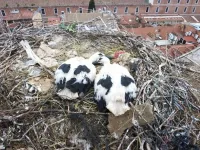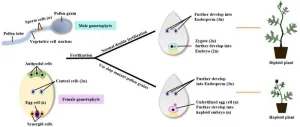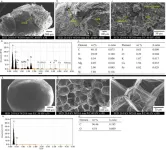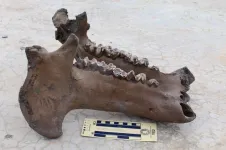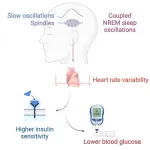(Press-News.org) We all discard a huge amount of plastic and other man-made materials into the environment, and these are often picked up by birds. New research has shown that 176 bird species around the world are now known to include a wide range of anthropogenic materials in their nests. All over the world, birds are using our left-over or discarded materials. Seabirds in Australia incorporate fishing nets into their nests, ospreys in North America include baler twine, birds living in cities in South America add cigarette butts, and common blackbirds in Europe pick up plastic bags to add to their nests.
This material found in birds’ nests can be beneficial say researchers. For example, cigarette butts retain nicotine and other compounds that repel ectoparasites that attach themselves to nestling bird’s skin and suck blood from them. Meanwhile, there are suggestions that harder man-made materials may help to provide structural support for birds’ nests, while plastic films could help provide insulation and keep offspring warm. Despite such potential benefits, it is important to remember that such anthropogenic material can also be harmful to birds.
This research was published in a special issue of the Philosophical Transactions of the Royal Society B on “The evolutionary ecology of nests: a cross-taxon approach”. The special issue was jointly organised by Mark Mainwaring, a Lecturer in Global Change Biology in the School of Natural Sciences at Bangor University.
Mark Mainwaring said,
“The special issue highlights that the nests of a wide range of taxa – from birds to mammals to fish to reptiles – allow them to adapt to human-induced pressures. Those pressures range from the inclusion of anthropogenic materials into their nests through to providing parents and offspring with a place to protect themselves from increasingly hot temperatures in a changing climate.”
Anthropogenic materials sometimes harm birds. Parents and offspring sometimes become fatally entangled in baler twine. Meanwhile, offspring sometimes ingest anthropogenic material after mistaking it for natural prey items. Finally, the inclusion of colourful anthropogenic materials into nests attracts predators to those nests who then prey upon the eggs or nestlings. This means that we need to reduce the amount of plastic and other anthropogenic material that we discard.
The lead author of the study, Zuzanna Jagiełło who is based at the Poznań University of Life Sciences in Poland, added,
“A wide variety of bird species included anthropogenic materials into their nests. This is worrying because it is becoming increasingly apparent that such materials can harm nestlings and even adult birds”. Zuzanna Jagiełło also went on to say that “more studies are needed to gain a more complete understanding of how many bird species worldwide include such materials into their nests for us to fully comprehend the extent of the problem.”
The second author of the study, Jim Reynolds, a researcher in the Centre for Ornithology at the University of Birmingham in the UK, remarked,
“In a rapidly urbanizing world which we share with many different animal taxa, it is not surprising that birds use our discarded materials in their nests. Although much needs to be understood about how plastics, for example, impact birds, it is exciting that birds, through their high mobility and breeding biology, may prove to be potent biomonitors of environmental anthropogenic material pollution.”
END
Man-made materials in nests can bring both risks and benefit for birds
Man-made materials are widespread in birds’ nests
2023-07-10
ELSE PRESS RELEASES FROM THIS DATE:
Li Yuan 's group from Northwest A&F University has made progress in the study of watermelon haploid induction
2023-07-08
Generating haploid plants for the purpose of obtaining pure doubled haploid (DH) lines is widely recognized as one of the most efficient breeding strategies in modern agriculture. Watermelon (Citrullus lanatus), an important fruit crop known for its nutritional value and flavor, has undergone long-term artificial selection resulting in genetic narrowing. Therefore, there is an urgent need for a haploid induction system to enhance traditional breeding methods and facilitate the development of valuable pure DH lines.
In March 2023, the Plant Biotechnology Journal published an online paper titled "Production of double haploid watermelon via ...
From bad to worse: h=How micro- and meso-plastics collect heavy metals
2023-07-08
Tokyo, Japan – A team led by researchers from Tokyo Metropolitan University studied how microplastics in the environment accumulate heavy metals. As the microplastics spread, so do their toxic cargo. Focusing on polystyrene foam, they collected particles along a river running through Ulaanbaatar, Mongolia. They found significant levels of heavy metals accumulated on the particles, reflecting local land use and industries, as well as surface features like holes and biofilms which help pollutants collect.
The spread of plastic debris into the natural environment is an ecological disaster. As plastic waste makes ...
Madagascar hippos were forest dwellers
2023-07-07
Extinct dwarf hippos that once roamed Madagascar lived in forests rather than open grasslands preferred by common hippos on mainland Africa, researchers at the University of Cincinnati discovered.
The findings suggest grasslands that now cover much of the enormous island off the eastern coast of southern Africa were a relatively recent change facilitated by people rather than a natural habitat sustained in part by these famously large vegetarians.
The study was published in the journal Plants, People, Planet.
When Madagascar broke away from Africa’s mainland 150 million years ago, its plants and animals evolved in geographic isolation in the ...
New research finds deep-sleep brain waves predict blood sugar control
2023-07-07
Researchers have known that a lack of quality sleep can increase a person’s risk of diabetes. What has remained a mystery, however, is why.
Now, new findings from a team of sleep scientists at the University of California, Berkeley, are closer to an answer. The researchers have uncovered a potential mechanism in humans that explains how and why deep-sleep brain waves at night are able to regulate the body’s sensitivity to insulin, which in turn improves blood sugar control the next day.
“These synchronized brain waves act like a finger that flicks the ...
Bilateral total knee arthroplasty linked to increased complication rates
2023-07-07
July 7, 2023 – Patients undergoing bilateral total knee arthroplasty (TKA) are at an increased risk of several types of complications, as compared with matched patients undergoing unilateral TKA, reports a study in The Journal of Bone & Joint Surgery. The journal is published in the Lippincott portfolio in partnership with Wolters Kluwer.
"Patients who underwent simultaneous bilateral TKA were at higher risk of experiencing postoperative complications such ...
New center merges math, AI to push frontiers of science
2023-07-07
ITHACA, N.Y. -- With artificial intelligence poised to assist in profound scientific discoveries that will change the world, Cornell is leading a new $11.3 million center focused on human-AI collaboration that uses mathematics as a common language.
The Scientific Artificial Intelligence Center, or SciAI Center, is being launched with a grant from the Office of Naval Research and is led by Christopher J. Earls, professor of civil and environmental engineering at Cornell Engineering. Co-investigators include Nikolaos Bouklas, assistant professor ...
Prostate cancer patients face financial toxicity: Who is affected and how do they cope?
2023-07-07
July 7, 2023 – Fifty percent of patients with metastatic prostate cancer experience some level of financial hardship due to their treatment, according to a study in the August issue of The Journal of Urology®, an Official Journal of the American Urological Association (AUA). The journal is published in the Lippincott portfolio by Wolters Kluwer.
"Our findings help in understanding the rates of and risk factors for financial toxicity among patients with advanced prostate cancer, along with the coping mechanisms, including the impact on personal spending, experienced by those reporting higher levels of financial toxicity," ...
Cancer’s origin story features predictable plot line, Stanford Medicine researchers find
2023-07-07
Cancer cells-to-be accumulate a series of specific genetic changes in a predictable and sequential way years before they are identifiable as pre-malignancies, researchers at Stanford Medicine have found. Many of these changes affect pathways that control cell division, structure and internal messaging — leaving the cells poised to go bad long before any visible signs or symptoms occur.
The study is the first to exhaustively observe the natural evolution of the earliest stages of human cancers, starting with ...
A novel chromosomal abnormality in AML patient: Case report and literature review
2023-07-07
“Here we report an unusual association of t (5; 17) with t (8; 21) in AML and we try to discuss the prognosis of this association and then the treatment.”
BUFFALO, NY- July 7, 2023 – A new research paper was published in Genes & Cancer on June 28, 2023, entitled, “A novel t (5; 17) (q35; q21) associated with t (8; 21) (q22; q22) in a patient with acute myeloid leukemia: case report and review of literature.”
The t (8; 21) (q22; q22) with the resulting RUNX1- RUNX1T1 rearrangement is one of the most common cytogenetic abnormalities in acute myeloid leukemia (AML). It is associated with a favorable prognosis. The t (5; 17) (q35; q21) is an ...
Art that integrates data visualizations can help bridge the US political divide over climate change
2023-07-07
MADISON – Communicating science to a general audience can be challenging. Successfully conveying research on polarizing topics such as climate change can be even more difficult.
But a new study from University of Wisconsin–Madison researcher Nan Li shows that intentionally integrating art with data visualizations can help non-expert audiences more meaningfully engage with climate change while also bridging political divides in ways that data alone cannot. In fact, data graphs on their own can exacerbate political division on climate change.
As an assistant professor in the Department of Life Sciences Communication, Li studies how innovative visual representations of science ...
LAST 30 PRESS RELEASES:
Geometry shapes life
A CRISPR screen reveals many previously unrecognized genes required for brain development and a new neurodevelopmental disorder
Hot flush treatment has anti-breast cancer activity, study finds
Securing AI systems against growing cybersecurity threats
Longest observation of an active solar region
Why nail-biting, procrastination and other self-sabotaging behaviors are rooted in survival instincts
Regional variations in mechanical properties of porcine leptomeninges
Artificial empathy in therapy and healthcare: advancements in interpersonal interaction technologies
Why some brains switch gears more efficiently than others
UVA’s Jundong Li wins ICDM’S 2025 Tao Li Award for data mining, machine learning
UVA’s low-power, high-performance computer power player Mircea Stan earns National Academy of Inventors fellowship
Not playing by the rules: USU researcher explores filamentous algae dynamics in rivers
Do our body clocks influence our risk of dementia?
Anthropologists offer new evidence of bipedalism in long-debated fossil discovery
Safer receipt paper from wood
Dosage-sensitive genes suggest no whole-genome duplications in ancestral angiosperm
First ancient human herpesvirus genomes document their deep history with humans
Why Some Bacteria Survive Antibiotics and How to Stop Them - New study reveals that bacteria can survive antibiotic treatment through two fundamentally different “shutdown modes”
UCLA study links scar healing to dangerous placenta condition
CHANGE-seq-BE finds off-target changes in the genome from base editors
The Journal of Nuclear Medicine Ahead-of-Print Tip Sheet: January 2, 2026
Delayed or absent first dose of measles, mumps, and rubella vaccination
Trends in US preterm birth rates by household income and race and ethnicity
Study identifies potential biomarker linked to progression and brain inflammation in multiple sclerosis
Many mothers in Norway do not show up for postnatal check-ups
Researchers want to find out why quick clay is so unstable
Superradiant spins show teamwork at the quantum scale
Cleveland Clinic Research links tumor bacteria to immunotherapy resistance in head and neck cancer
First Editorial of 2026: Resisting AI slop
Joint ground- and space-based observations reveal Saturn-mass rogue planet
[Press-News.org] Man-made materials in nests can bring both risks and benefit for birdsMan-made materials are widespread in birds’ nests
